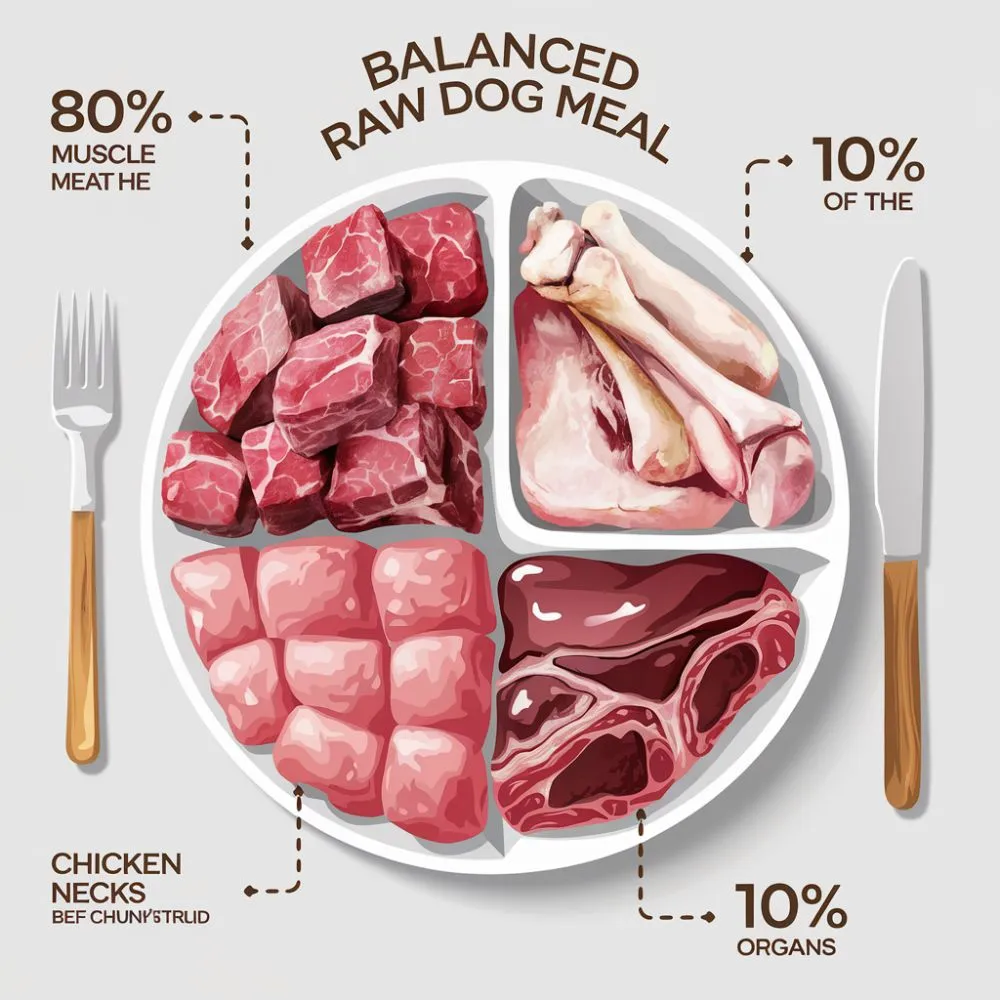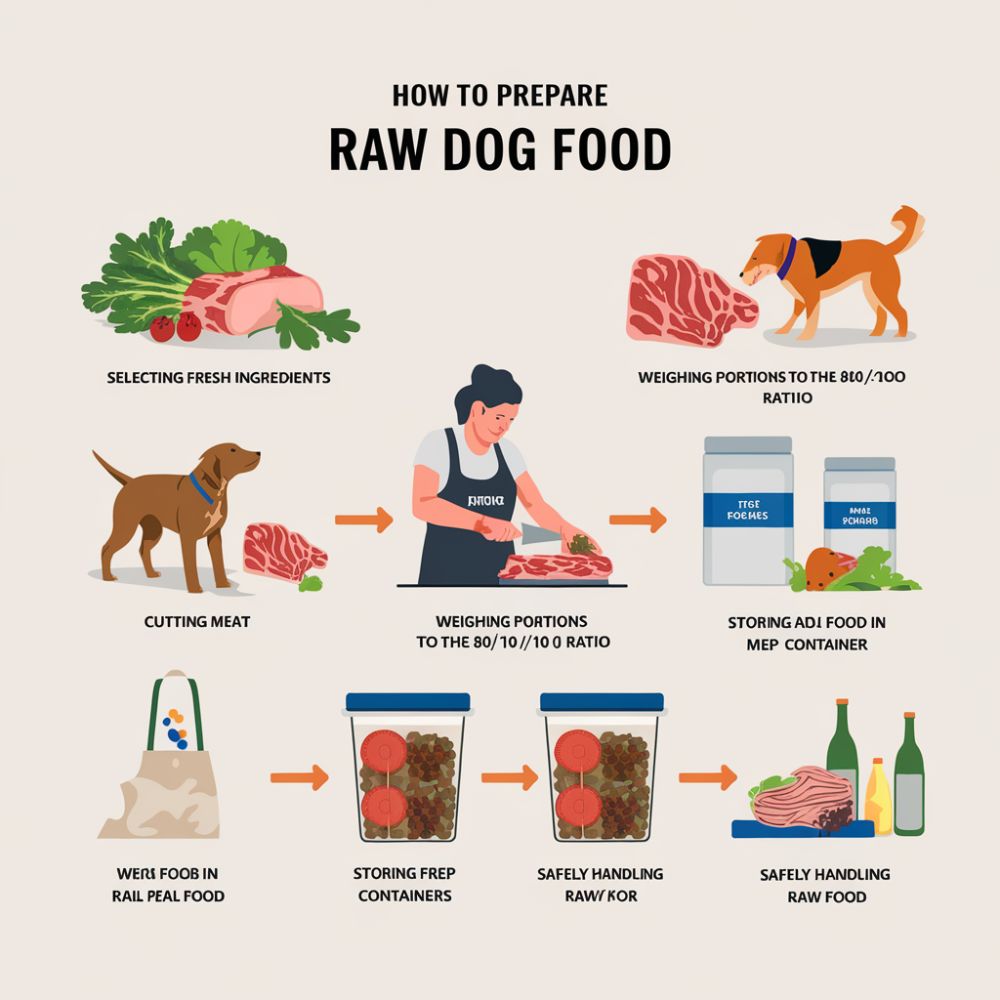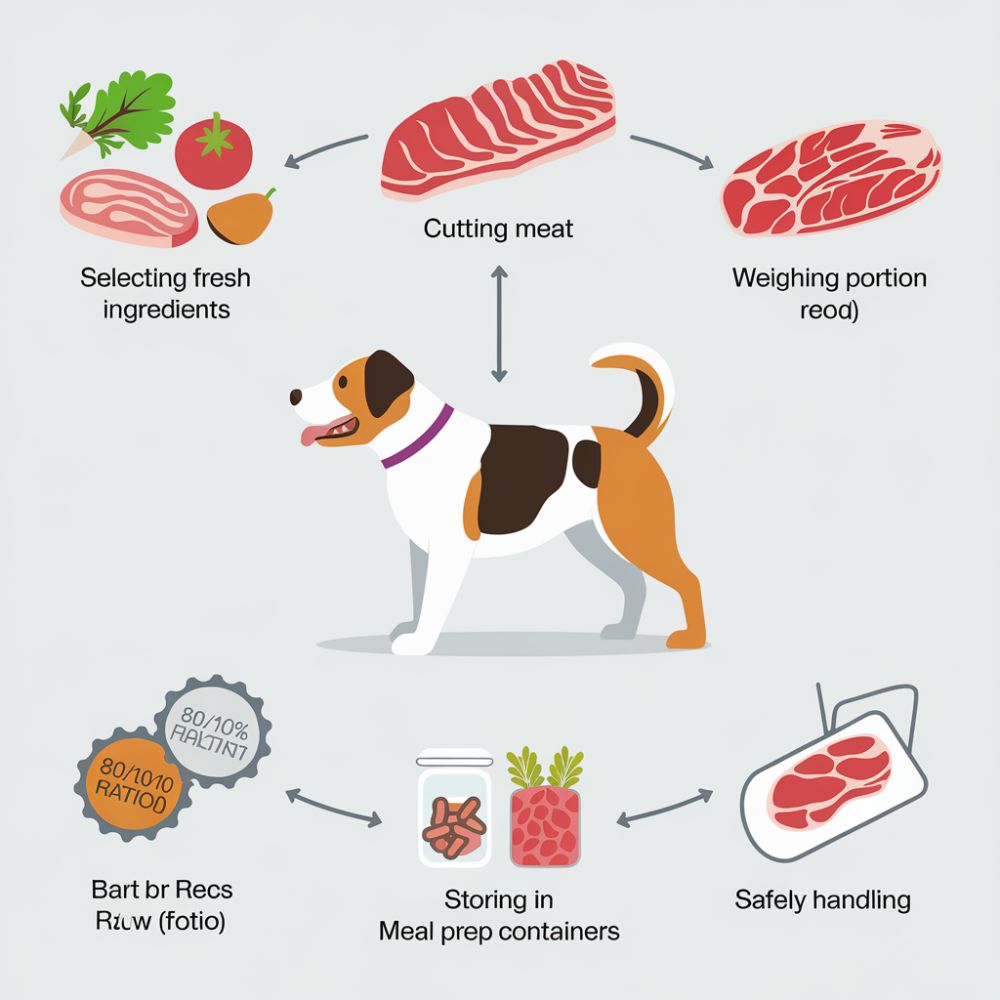Dogs, our loyal companions, have roamed alongside humans for thousands of years. While domestication has softened their wild instincts, their fundamental dietary needs remain largely unchanged. Enter the 80/10/10 raw dog food diet, a nutritional model that seeks to replicate the natural feeding patterns of wild canines.
But what does this diet entail, and is it the best choice for your furry friend? Let’s break it down.
What is the 80/10/10 Raw Dog Food Diet?
At its core, the 80/10/10 raw dog food is a species-appropriate diet, a raw food regimen consisting of:
- 80% muscle meat
- 10% raw edible bone
- 10% organ meat (5% liver and 5% other organs)
This breakdown mirrors the natural prey model raw diet that wild dogs and wolves consume, providing a balance of protein, fat, minerals, and vitamins essential for optimal canine health.
The Components Explained
1. Muscle Meat (80%)
Muscle meat forms the bulk of a raw diet and provides essential proteins and amino acids crucial for muscle development, tissue repair, and overall health. Sources include:
- Beef
- Chicken
- Turkey
- Lamb
- Fish
- Duck
Muscle meat also supplies essential fats, which serve as an energy source and support skin and coat health.
2. Raw Edible Bone (10%)
Best Raw Bones for dogs are a rich source of calcium and phosphorus, crucial for skeletal health. They also provide dental benefits by reducing plaque and tartar buildup. Some suitable bone choices include:
- Chicken wings, necks, and backs
- Turkey necks
- Duck necks
- Beef ribs (for larger dogs)
It’s important to use raw, meaty bones that are soft and digestible, avoiding cooked bones that can splinter and cause harm.
3. Organ Meat (10%)
Organs are nutrient powerhouses, providing vitamins, minerals, and essential fatty acids. The two categories include:
- Liver (5%): High in vitamin A, iron, and B vitamins.
- Other Organs (5%): Kidneys, spleen, pancreas, and brain, which provide additional micronutrients and enzymes beneficial for overall health.
Benefits of the 80 10 10 Raw Dog Food
Switching to a raw, species-appropriate diet can lead to remarkable improvements in your dog’s health. Here’s why many pet owners swear by it:
1. Improved Digestion
Kibble is packed with fillers and carbohydrates that dogs struggle to digest. Raw food, on the other hand, aligns with their natural digestive system, leading to firmer stools, less bloating, and fewer digestive issues.
2. Healthier Skin & Coat

The natural fats and omega fatty acids found in raw meat promote a glossy coat and healthy skin, reducing raw feeding allergies and itching.
3. Stronger Teeth & Gums
Gnawing on the best raw bones for dogs naturally cleans teeth, reducing plaque and bad breath without the need for dental treats or professional cleanings.
4. Lean Muscle & Optimal Weight
Since raw food is free of unnecessary carbohydrates and fillers, dogs maintain a healthy weight, reducing the risk of obesity-related diseases.
5. Boosted Energy Levels
The natural proteins and fats in the 80/10/10 diet give dogs sustained energy throughout the day. This can be especially beneficial for working dogs or those with active lifestyles.
6. Reduced Raw Feeding Allergies
Processed food can often trigger allergies. A raw diet minimizes exposure to artificial additives and allergens, allowing sensitive dogs to thrive.
7. Behavioral Balance a Raw Dog Diet
Many advocates of the 80 10 10 raw dog food claim that their dogs are calmer, more focused, and less hyperactive. This could be due to the diet’s direct impact on gut health and overall well-being.
Pros & Cons of the Raw Dog Food 80/10/10
| Pros | Cons |
|---|---|
| Species-appropriate, natural diet | Requires proper meal balancing |
| Improved digestion and firmer stools | Needs freezer space for storage |
| Healthier skin, coat, and teeth | Risk of bacterial contamination if handled improperly |
| Helps maintain the ideal weight | Not suitable for all dogs (e.g., those with certain medical conditions) |
| Higher energy levels and vitality | It can be expensive, depending on the meat quality |
Who Should Avoid This 80 10 10 Dog Diet?
While raw dog food 80 10 10 benefits many dogs, some may require modifications or should avoid it entirely:
- Dogs with kidney disease: High protein intake may strain compromised kidneys.
- Dogs with pancreatitis: Fat content needs to be closely monitored and adjusted.
- Dogs with immune system disorders: Raw meat carries a risk of bacterial contamination, which could be harmful to immunocompromised pets.
- Senior dogs or those with weak teeth: Softened or ground alternatives may be needed.
Consult your vet before switching to an 80:10:10 raw dog food diet if your dog falls into any of these categories.
How to Get Started with the 80 10 10 Dog Diet
Switching your dog’s food can feel daunting, but a gradual and informed transition can set your pet up for success.
Step 1: Raw Food Transition For Dogs Gradually
Don’t switch from kibble to raw overnight. Switching to a raw diet requires careful planning to avoid digestive upset. Here’s a step-by-step guide:
- Gradual Transition: Start by mixing small amounts of raw food with your dog’s current diet, replacing one meal per day with raw food and gradually increasing the raw portion over 7–10 days.
- Choose Simple Proteins First: Begin with a single protein source (like chicken or beef) before introducing variety.
- Monitor Stool & Digestion: Slight digestive changes are normal, but persistent diarrhea or vomiting signals a need for adjustment.
- Introduce Organs Slowly: Organs are nutrient-dense and can cause loose stools if introduced too quickly.
- Ensure Hydration: Always provide fresh water, as raw-fed dogs may drink less due to the high moisture content in their food.
Step 2: Calculate Portion Sizes
The general rule is to feed your dog 2-3% of their body weight daily. For example:
A 20 kg dog may need about 400-600 grams of food per day.
Step 3: Source Quality Ingredients
Choose grass-fed or free-range meats when possible. Buy from trusted butchers or suppliers. Some companies specialize in pre-packaged 80/10/10 meals for convenience.
Step 4: Balanced the Components

Ensure you stick to the 80/10/10 proportions. Avoid overfeeding liver or organ meat, as it can lead to vitamin toxicity.
Step 5: Practice Safe Handling

Handle raw food with care to minimize bacterial contamination:
- Wash hands and utensils thoroughly.
- Store raw meat in sealed containers and freeze portions you won’t use immediately.
Common Misconceptions & Concerns
Despite its benefits, the 80/10/10 raw diet isn’t without controversy. Let’s address some common concerns:
1. “Is raw food dangerous due to bacteria?”
While raw meat can contain bacteria like Salmonella or E. coli, dogs have highly acidic stomachs designed to handle raw food safely. Proper hygiene, such as freezing meat before feeding and cleaning food prep areas, minimizes risks.
2. “Won’t bones splinter and cause harm?”
Cooked bones are dangerous, but raw bones are softer and digestible. Always supervise your dog and choose bones appropriate for their size.
3. “Is the diet nutritionally completely Raw?”
If properly balanced using quality ingredients, the 80-10-10 raw food diet provides all the necessary nutrients. Some owners supplement with additional vitamins, minerals, or omega-3 fatty acids to ensure comprehensive nutrition.
4. “It’s Too Expensive”
While premium meats can be costly, the overall investment in your dog’s health often saves on future vet bills. Bulk buying and meal prepping can also reduce costs.
80/10/10 Raw Dog Food Recipes and Meal Examples
Here are some sample meal ideas to inspire your raw feeding journey:
1. Small-sized dog (5–10 kg)
- Breakfast: 100g chicken thigh meat, 20g liver, 20g chicken necks.
- Dinner: 80g ground beef, 20g kidney, 20g duck feet.
2. Medium-Sized Dog (20–25 kg)
- Breakfast: 200g turkey breast, 50g beef liver, 50g pork ribs.
- Dinner: 250g lamb shoulder, 50g chicken heart, 50g duck wings.
3. Large-sized dog (40+ kg)
- Breakfast: 400g beef cuts, 100g pork kidney, 100g turkey necks.
- Dinner: 500g whole rabbit (with bones), 100g liver, 100g beef spleen.
DIY vs. Pre-Made Raw Meals
DIY Raw Feeding
Preparing raw meals at home allows full control over ingredient quality and sourcing. However, it requires time, effort, and knowledge to ensure balanced meals.
Pre-Made Raw Food

For those with busy lifestyles, commercially available raw food brands offer convenience while maintaining nutritional balance. Look for reputable brands with high-quality sourcing standards.
Is the 80/10/10 Diet Right for Every Dog?
While the 80-10-10 raw food diet works for many dogs, individual needs vary. Some dogs may require adjustments, such as:
- Additional fiber (pumpkin, leafy greens) for digestive health.
- More omega-3 fatty acids (fish oil) for joint and coat health.
- Modified fat content for senior or less active dogs.
Dogs with specific health conditions (e.g., kidney disease) may need a specialized diet, so always consult with a veterinarian before making significant dietary changes.
Supporting References & Expert Opinions
- American Veterinary Medical Association (AVMA) – Insights on raw feeding and bacterial risks. Read More
- Dr. Karen Becker (Veterinarian & Nutritionist) – Advocates for species-appropriate diets and raw feeding. Read More
- Raw Feeding Veterinary Society (RFVS) – Research-backed recommendations on raw pet nutrition. Read More
FAQs About the Raw Dog Food 80/10/10?
Q1.What are the best protein sources for the 80-10-10 raw food diet?
Ans. The best protein sources include beef, chicken, turkey, lamb, fish, and duck. Rotating proteins ensure a wide range of nutrients.
Q2.Can I feed my dog cooked bones instead of raw bones?
Ans. No. A cooked bone can splinter and cause serious harm. Only feed raw, soft, edible bones.
Q3.How do I store raw dog food safely?
Ans. Store raw meat in the freezer and thaw portions in the refrigerator before feeding. Always practice proper food safety and sanitation.
Q4.How much raw food should I give my dog daily?
Ans. Generally, feed 2-3% of your dog’s body weight daily, adjusting based on activity level and weight goals.
Q5.Can puppies eat 80/10/10 raw dog food diet?
Ans. Yes, but they require more frequent meals and slightly different nutrient ratios to support growth. Consult a vet to ensure proper balance in a raw dog diet.
Conclusion of 80/10/10 Raw Dog Food:
The raw dog food 80 10 10 diet champions a return to biologically appropriate nutrition, providing numerous health benefits. While it requires education, commitment, and careful planning, many dog owners find the rewards—shiny coats, lean muscles, and boundless energy—well worth the effort.
If you’re considering transitioning your pup to raw feeding, research, consult your vet, and ensure you’re meeting their nutritional needs. After all, a well-fed dog is a happy, healthy companion for years to come!

